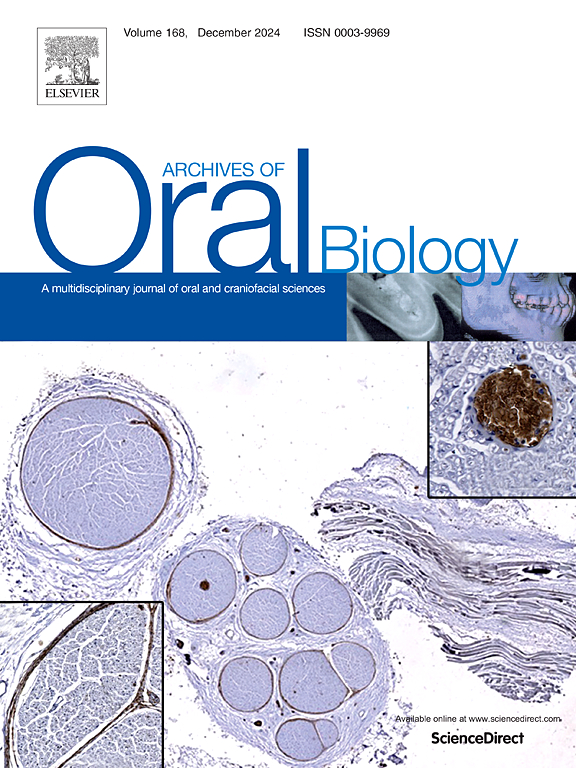腰果多糖对体外食管上反流模拟下牙本质侵蚀进展的局部影响
IF 2.1
4区 医学
Q2 DENTISTRY, ORAL SURGERY & MEDICINE
引用次数: 0
摘要
目的:体外评价腰果多糖(PLS-cg)对牙本质在模拟口腔内反流接触的侵蚀循环中的局部作用。设计:将人牙本质块制备、标准化并随机分配到三个治疗组(n = 10)中的一个:对照组(C)未治疗,商用牙清漆(CDV) 5 % NaF氟化物清漆和PLS-cg提取物(实验组)。评估基线牙釉质表面显微硬度(HK)和粗糙度(Ra)。使用盐酸-胃蛋白酶溶液(pH 2; 0.75 mg/mL胃蛋白酶)对牙本质进行侵蚀循环(6 × 5 分钟/天,持续9天)。采用表面粗糙度(Ra)、显微硬度(HK)、表面硬度损失率(%SHL)和扫描电镜形貌分析(SEM)来评价杂多糖的保护作用。预测分子对接模拟用于研究PLS-cg与金属蛋白酶(MMP2和MMP9)之间可能的相互作用。对数据进行双向方差分析、t检验、Pearson相关和Tukey检验(p )结果:PLS-cg保存HK显著优于对照组(p )结论:PLS-cg可减少胃食管反流病食管上表现引起的牙本质糜烂。本文章由计算机程序翻译,如有差异,请以英文原文为准。
Topical effect of polysaccharide cashew gum on the mitigation of dentin erosion progression under in vitro supraesophageal reflux simulation
Objective
To evaluate, in vitro, the topical effect of polysaccharide cashew gum (PLS-cg) on dentine subjected to erosive cycles that simulate refluxate contact in the oral cavity.
Design
Human dentine blocks were prepared, standardized, and randomly assigned to one of three treatment groups (n = 10): control group (C) without treatment, commercial dental varnish (CDV) 5 % NaF fluoride varnish, and PLS-cg extract (experimental group). The baseline enamel superficial microhardness (HK) and roughness (Ra) were assessed. The dentin was subjected to erosive cycles (6 × 5 min/day for 9 days) using a hydrochloric acid–pepsin solution (pH 2; 0.75-mg/mL pepsin). Surface roughness (Ra), microhardness (HK), percentage surface hardness loss (%SHL), and topographic analysis with scanning electron microscopy (SEM) were used to evaluate the protective heteropolysaccharide effect. Predictive molecular docking simulations were used to investigate possible interactions between PLS-cg and metalloproteinases (MMP2 and MMP9). The data were analyzed with two-way analysis of variance, t test, Pearson’s correlation, and Tukey’s test (p < 0.05).
Results
PLS-cg preserved HK significantly better than the control group (p < 0.001), with the lowest %SHL (-14.04 ± 8.22) and minimal Ra changes (0.124 ± 0.005). Pearson’s correlation between Ra and %SHL was significant and positive (0.7740, p < 0.001). SEM analysis revealed more prominent dentinal tubule openings in the control group, whereas CDV and PLS-cg showed tubule obliteration. Molecular docking identified possible interactions between PLS-cg and MMPs.
Conclusion
The findings indicate that PLS-cg may reduce dentine erosion caused by supraesophageal manifestations of gastroesophageal reflux disease.
求助全文
通过发布文献求助,成功后即可免费获取论文全文。
去求助
来源期刊

Archives of oral biology
医学-牙科与口腔外科
CiteScore
5.10
自引率
3.30%
发文量
177
审稿时长
26 days
期刊介绍:
Archives of Oral Biology is an international journal which aims to publish papers of the highest scientific quality in the oral and craniofacial sciences. The journal is particularly interested in research which advances knowledge in the mechanisms of craniofacial development and disease, including:
Cell and molecular biology
Molecular genetics
Immunology
Pathogenesis
Cellular microbiology
Embryology
Syndromology
Forensic dentistry
 求助内容:
求助内容: 应助结果提醒方式:
应助结果提醒方式:


